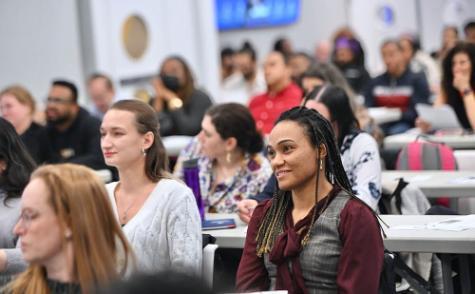Exploring the Mind-Body Connection: Touro University Social Work Students Embrace Somatic Therapy for Trauma Healing
At Annual Community Day, Students Discover Powerful Tools for Personal and Professional Growth

Students at the Touro University Graduate School of Social Work gathered recently at Touro’s new Cross-River campus in the heart of Times Square for their annual “Community Day” event, where they connected with classmates and faculty and gained skills and advice related to their MSW journeys.
This year, they did more than discuss trends and engage with experts in the field; they touched their heads and hearts and explored first-hand with a psychotherapist the mind-body connection and how understanding it can help healing from trauma.
Known as somatic therapy, the practice explores how the body expresses deeply painful experiences and applies mind and body healing to aid with trauma recovery.
“Somatic Intervention is a technique which allows you to sense and interrupt habitual patterns like anxiety, stress or fear – release the bodily tension, process associated memories, and move forward in a more centered way,” explains Ricki Bernstein, LMSW, SEP, the guest speaker and psychotherapist.
Hands on Your Head
Bernstein shared a slide presentation about brain development and how different parts of the brain function in coping with stress. She explained what happens to the body during trauma and how breathing can calm things down.
Moving around the room with a microphone, she engaged the audience in movement exercises and instructed them to place their hands on different body parts, such as their stomach, face, chest and head. Then she asked the students how they felt. Many were impressed.
“It was mind-blowing,” said Norana Krkuti, who plans to use the technique with clients at the community health agency AthenaPsych, where she’s accepted a position and will begin in June.
“We’re going to be graduating and be social workers. To have this actual tool is amazing. If you’re under stress it grounds you. You’re able to have clarity and feel a sense of peace. The breathing technique puts a person in touch with their body and leads to a calmer state,” said Krkuti.
Engy Fathalla said that trying the exercises at Community Day did not immediately rid her of a headache and she grew frustrated, but after Bernstein worked with her, it went away.
“I told her I didn’t feel anything,” said Fathalla. “Then she taught me how to control my breathing and to do the exercises in a specific way. After that I felt more relaxed.”
A former journalist in her native Egypt, Fathalla said she plans to work as a therapist after she becomes a licensed MSW, and after further study she hopes to use the somatic approach in her practice.
A Tool for both Social Workers and Clients
Stephanie Espinal, who works as a case manager at the mental health clinic Interborough Development & Consultation Center, said she plans to use the technique as a bilingual therapist once licensed. Espinal stressed the value of the technique for both social workers and clients.
“For social workers, we’re so busy trying to support others,” she observed. “We definitely need this kind of therapy in practice, especially in the times we’re living in now.”
“If there’s a moment where the client is in extreme distress, it’s a great exercise to practice to redirect the tension and the anxiety and be able to pause and be in the present moment. It encourages self-care and being present with yourself,” said Espinal.

